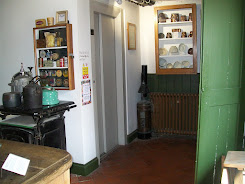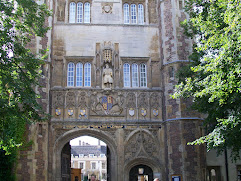After two days’ rest it was time for another sojourn, a return to Cambridge and other sites of ‘The Missing Three-Quarter’ not visited on the previous occasion, focusing on Dr. Leslie Armstrong and the journey of 10 or 12 miles that he leads Holmes on.
SIR:
![]() I can assure you that you are
wasting your time in dogging my movements. I have, as you discovered last
night, a window at the back of my brougham, and if you desire a twenty-mile
ride which will lead you to the spot from which you started, you have only to
follow me. Meanwhile, I can inform you that no spying upon me can in any way
help Mr. Godfrey Staunton, and I am convinced that the best service you can do
to that gentleman is to return at once to London and to report to your employer
that you are unable to trace him. Your time in Cambridge will certainly be wasted.
I can assure you that you are
wasting your time in dogging my movements. I have, as you discovered last
night, a window at the back of my brougham, and if you desire a twenty-mile
ride which will lead you to the spot from which you started, you have only to
follow me. Meanwhile, I can inform you that no spying upon me can in any way
help Mr. Godfrey Staunton, and I am convinced that the best service you can do
to that gentleman is to return at once to London and to report to your employer
that you are unable to trace him. Your time in Cambridge will certainly be wasted.
Yours faithfully,![]()
LESLIE ARMSTRONG.
Catching a train from London Liverpool Street, I arrived again at Cambridge Station where Holmes and Watson did in the story. The station opened in 1845. Although remodelled in 1863 and 1908 the station buildings are contemporary with the story. The station hosts the third longest railway platform in the UK.


From here I caught a bus to the far side of the city centre, and after a short walk, reached my first port of call, the Museum of Cambridge. The museum is a Grade II listed 16th century former coaching inn, and over three floors hosting over 40,000 objects related to the everyday life, customs, and traditions of the local people of the Cambridgeshire area, represents over 300 years of local history.
The reason for my visit was that museum was hosting an exhibition, “Agatha Christie: Her Life and Characters”, with the large private collection of Gale Goddard - books, clothing and character ephemera - being on display in one of the upper rooms.

Having made straight for the ‘Agatha Christie’ exhibition, I then wandered around the other rooms of the museum.


Leaving the museum, and wandering along the side of the Cam, after around fifteen minutes walk, I reached the first of the ‘Missing Three-Quarter’ sites. This was the village of Chesterton, which is one of the villages listed by Holmes as he follows upon the tracks of Armstrong, searching for Godfrey Staunton. The former villages visited by Holmes have been almost entirely subsumed in the growth of the modern city of Cambridge, with only a few traces of the former countryside. However, I managed to take photos of a village green and St. Andrew’s Church, Chesterton.
Retracing some of my route I found that the bus stop that I intended to use to get to my next village was ‘out of service’ and had to continue walking for another ten minutes to get to the previous one. From here I caught a bus along Cambridge’s Busway, the longest guided busway in the world which connects Cambridge, Huntingdon and St Ives, to Oakington, another of the villages listed by Holmes.


Photos taken, and I was getting back onto the Busway, back one stop to Histon and Impington, the former being another of the villages listed by Holmes.
Catching a bus back into central Cambridge, I alighted just by Sidney Sussex College, identified by Dorothy L. Sayers as Holmes’ college as it ‘offered the greatest number of advantages to a man in Holmes' position’.
Another short walk brought me to Trinity College, the college of both Cyril Overton and Jeremy Dixon in ‘The Missing Three-Quarter’.
Continuing on, after around fifteen more minutes, I reached Trumpington Road. In ‘The Missing Three-Quarter’, the home of Dr Leslie Armstrong, head of Cambridge University Medical School, is described as ‘a large mansion in the busiest thoroughfare’. Scholars have concluded that this is most likely a description of a large townhouse on the busy Trumpington Road. Armstrong was initially taken by Holmes to be his antagonist, but was found to be assisting the missing Godfrey Staunton and his very ill wife. Having identified such a townhouse, I took several photos.
I then waited and waited for a bus back to the Railway Station, with at least one service being cancelled. I therefore arrived back too late for my planned train to Waterbeach, the final village listed by Holmes.
Instead, I caught a train back to London, where my evening was spent at the Criterion Theatre (just next to where Watson met Stamford) in watching ‘The Way Old Friends Do’, written by and starring Ian Hallard (Jim Moriarty’s defence solicitor in ‘The Reichenbach Fall’), and directed by Ian’s husband, Mark ‘Mycroft’ Gatiss. The performance which was excellent, ended with a post-show Q&A with Ian and Mark, and I managed to get a photo with Ian at the stage door and Mark to sign a photo of himself as Mycroft.
























